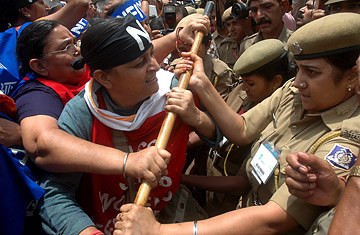
Indian police try to stop women activists protesting outside the Indian parliament in New Delhi, India.
No one can accuse the Indian legislature of doing things in a hurry. Or of doing them quietly. Sixteen years after a measure reserving one third of parliament's seats for women was first introduced in Parliament, a bill to this effect was introduced for the fourth time last week. Parliamentarians opposed to the bill rushed toward the Law Minister to snatch copies from his hands and physically prevent him from introducing it, while the hapless minister sought refuge between two women ministers — who looked on startled and amused and eventually matched their male rivals in a fine display of lung power.
The bill was finally introduced despite the high drama, and the Congress Party–led government could claim to have kept its promise. But no one seriously believes Congress is committed to seeing the measure enacted into law — it was introduced just four days before the parliamentary session was to close. Now, it will be examined — yet again — by a parliamentary committee, until it is taken up for discussion and possibly voting in the monsoon session of parliament that begins in July. Some of the bill's most virulent opponents are part of Congress's coalition, including Railways Minister Lalu Prasad Yadav, and the ruling party is not about to upset an apple cart already teetering due to soaring inflation and the jinxed Indo-U.S. nuclear deal.
Opponents of the bill are acting as much out of political expediency as out of plain old-fashioned gender bias. Smaller but influential caste-based parties, which often revolve around a few all-powerful leaders, think their influence will dwindle if established leaders have to make room for newer, inexperienced women representatives. At present, there are 50 women among the 543 members of the lower house of Parliament, the Lok Sabha — just 9%. If the bill were passed, the number would have to rise to 181, meaning scores of male leaders would have to make way.
There is a degree of irony in an affirmative action for women politicians bill being introduced at a time when two of the most important players in the country's politics are women — Congress Party President Sonia Gandhi and Bahujan Samaj Party leader Mayawati, who may or may not become Prime Minister but can upset everyone else's calculations. But it may simply be an admission that India's long tradition of powerful women in politics — from Sarojini Naidu, who became the first woman to lead the Indian National Congress in 1925 during its struggle for independence from Britain, to Indira Gandhi, who became the country's first woman Prime Minister in 1966, and the plethora of women ministers and state chief ministers that have followed — has not improved the lives of the majority of Indian women. In keeping with South Asian tradition, most high-profile women politicians in India — with a few notable exceptions — have reached the top on the shoulders of illustrious fathers or husbands. Once elected, they have not beaten the system, but mostly perpetuated it. None has ever made women's issues a central plank of their politics.
One reason successive Indian governments have failed to pass the bill reserving seats for women is that women's issues and perspectives are not on any of the parties' electoral radar. Delhi's Chief Minister, Sheila Dixit, for example, was reelected after improving the city's transport system and pollution levels, despite a shocking increase in crimes against women on her watch. Moreover, women voters, just like women politicians, are swayed more by party affiliations than by gender — for example, there has been no groundswell of support for Mayawati from women voters. Gender issues have simply not been part of the mainstream political discourse. So try as India's feminists might to shame male politicians into passing a bill reserving seats for women, their chances of success are slim in a political culture in which shamelessness is par for the course.
